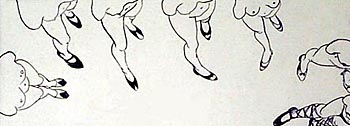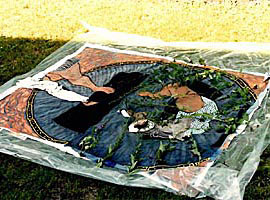Printmaking Definitions: Cyannotypes
Intaglio / Etching | Drypoint | Lithography | Relief Printing | Screen Collograph | Cyannotypes | Viscosity Printing
The Cyanotype process is a photographic process, often used by architects to make blueprints and other images that are a beautiful deep indigo blue colour. Two chemicals, Ammonium iron (III) citrate and Potassium ferricyanide are mixed together and brushed on paper or fabric and dried in the dark. Once dried and exposed to light, the surface turns shades of indigo blue. Objects, or photographic images can be placed on top of the surface while being exposed to light. When the amount of light exposure is achieved then it is set by rinsing in a bath of water.
Cyannotypes: see link for more information.

A cyanotype solution brushed on a xerox transfer monoprint by Gisele Beaupre
A cyannotype solution brushed onto fabric on a double blind print being exposed to light. Leaves and such were placed on top of the print which blocks the light, which allows for gradations of blue. The fabric is then washed off with water.
Another example using cyannotype:
 Hand Clasp, using cyannotype and screen collograph process
Hand Clasp, using cyannotype and screen collograph process
Designed by Gisele Beaupre ©

